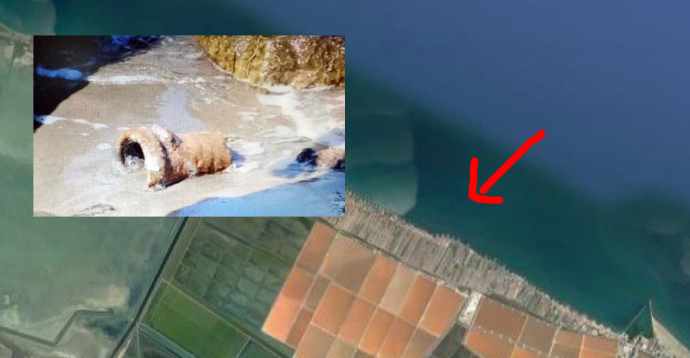 The demonstration, yet another, that an ancient history – all to be reconstructed – in the marine waters of Margherita di Savoia is confirmed by a new important archaeological discovery :
The demonstration, yet another, that an ancient history – all to be reconstructed – in the marine waters of Margherita di Savoia is confirmed by a new important archaeological discovery :

 Segui tutte le news iscrivendoti al gruppo Whatsapp dedicato alla Provincia di Barletta-Andria-Trani oppure iscrivendoti sul canale Telegram cliccando qui.
Segui tutte le news iscrivendoti al gruppo Whatsapp dedicato alla Provincia di Barletta-Andria-Trani oppure iscrivendoti sul canale Telegram cliccando qui.
According to what is learned, in the month of June, some pieces of ancient amphorae were found by the soldiers of the Coast Guard of Margherita di Savoia during the surveillance and control activities of the coast. Specifically, the fragments of various shapes – such as handles, necks and bellies – were found in the northern area of the town in the Quarto – Orno area : “The intervention of the staff of the local maritime office made it possible to prevent the finds from being stolen from predators and that they were placed on the illegal market”, observe from the coast guard. From the maritime office they remind not only that“in the event of archaeological finds at sea, you are invited to immediately contact the local maritime authority for the activation of the relative recovery procedures” but also that “the simple removal for personal use constitutes an offense punishable by law “ . The archaeological finds discovered will be handed over to the superintendency of archaeological heritage of Foggia which will take care of the cataloguing, study and research. The discovery could easily indicate the presence of something else:
Perhaps the remains of an ancient village buried by the waters due to the rising sea level? The remains of goods transported by an ancient shipwrecked ? Only in-depth studies by experts will reveal new details and perhaps even the origins of these artefacts. After all, we are in the territory of a city – Margherita di Savoia , in the province of Barletta-Andria-Trani – whose salt pans, the largest in Europe, were already known at least since the time of the Roman Empire . From the fragmentary information that has come down to the present day, we know that with the spread of Christianity, the locality assumed the name of Sancta Maria de Salinis and thus she is mentioned in a donation diploma of Godfrey the Norman , count of Canne, in 1105:
The farmhouse of Sancta Maria de Salinis , still of uncertain location, (perhaps it stood a little further north of today’s town near the hamlet of Orno and today would be submerged) was part of the territory and diocese of Canne together with the farmhouse of San Cassiano (today’s San Ferdinando) and San Nicolao de Petra, today’s fraction of Torre Pietra, which perhaps gave birth, according to the Life published by Ughelli , to Ruggero, bishop of Barletta . From the sources we learn that the farmhouse had a church, to which a farmhouse was also annexed and under Frederick II it was equipped with a watchtower:
Also from the deed of donation we learn that the territory of this farmhouse was bordered to the north by the district of San Nicolao di Petra and to the south by the Ofanto. At the time, the salt marshes were called Salinae Cannarum, as the bishop of Canne owned them and collected the census. The farmhouse was then once again ceded to the Templars of Barletta by Bishop Joannes , who succeeded San Ruggiero in the episcopate of Canne. With the extinction of the diocese of Canne, the church of Santa Maria de Salinis was aggregated to that of Trani , to which it still belongs today, as shown by the bull of Pope Celestine III , dated 1192 . The dominion of the Templars over the salt pan ended with the issuing of theConstitution of Melfitane by Frederick II , who established the salt monopoly. Under the House of Swabians, the locality experienced a period of great flowering. The city experienced the devastating effects of the earthquake-tsunami of 1223 which also struck nearby Siponto , but was promptly rebuilt by Charles II of Anjou in 1275. The farmhouse, however, fell into ruin due to the progressive swamping of Lake Salpi, which must have caused epidemics of malaria, but a not indifferent role was also played by the erosion phenomenon of the coast, still in progress. As if that weren’t enough, between the end of the 13th century and the beginning of the 14th, the hamlet of Sancta Maria de’ Salinis was decimated by a serious malaria epidemicand the few survivors took refuge in Barletta: apparently, the inhabitants of the ancient marshy area never integrated with the people of Barletta, forced to live outside the city walls. However, this phenomenon would have made it possible to preserve the cultural and historical genetic identity of the salt workers. About two centuries passed before the authorities decided to reclaim the area. In this regard, the following publications are recalled:
“Salapia and Salinis ” (Lopez, 1971), “The salt marshes environment from dialect to history” (Lopez, 1973-75), “Margherita di Savoia and her ancient submerged settlements” (Lopez, 1981), “Torre delle Saline and the towers of Petra, Rivoli, Ofanto in the context of the coastal defense of the Kingdom of Naples” (Lopez, 1986), “The Mother Church of the SS. Salvatore di Margherita di Savoia, the Salinarum churches and chapels” (Lopez, 1987) , “Old Liberty railings in the historic center of Margherita di Savoia” (Lopez, 1989), “Salinae Cannarum-Sancta Maria de Salinis” (Lopez, 1996). “Geomorphology and Culture of the Gargano Promontory and surrounding areas” (Lopez, 2000). “The Marian cult in the North-Ophantine area” (Lopez, 2002). (Source:
Regarding the PugliaReporter.com blog , we remind you that it is possible to receive all the news in real time from Telegram by registering at the following address > https://t.me/pugliareporter < from Instagram at the following address > instagram.com/puglia_reporter < as well as from Facebook by clicking ” like ” on Facebook.com/PugliaReporter and from Twitter at the following address > twitter.com/pugliareporter < . Also through Telegram it is also possible to send us reports in real time also withvideos and photos . It is also possible to write to us via Whatsapp to send us reports also with photos and videos by clicking here and subscribe to the Whatsapp group to receive our links by clicking here .
- Segui VideoAndria.com:
- Su Facebook cliccando qui
- Su Telegram cliccando qui
- Su Whatsapp cliccando qui
- Su Twitter cliccando qui
- Su Instagram cliccando qui
Ricordiamo che è possibile ricevere tutte le news in tempo reale dall'app gratuita Telegram iscrivendosi al seguente indirizzo: https://t.me/andriabarlettatrani. Sempre attraverso Telegram è possibile inviarci segnalazioni in tempo reale anche con video e foto. Ricordiamo inoltre che cliccando "MI PIACE" sulla Pagina https://www.facebook.com/videoandria.notizie/ è possibile seguire tutte le news da Facebook. E' possibile scriverci anche via Whatsapp per inviarci segnalazioni anche con foto e video cliccando qui ed iscriversi al gruppo per la ricezione dei nostri link cliccando qui. Ricordiamo, inoltre, che è possibile seguire tutti i nostri tweet all'indirizzo https://twitter.com/videoandria. Gli aggiornamenti di VideoAndria.com sono anche su linkedin.com/company/andrianews e su https://vk.com/andrianews.


